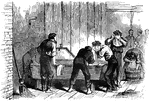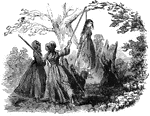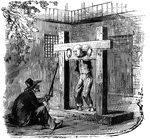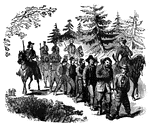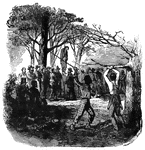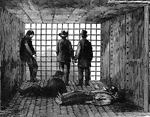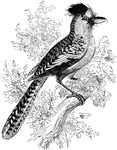
Batara
Taking its name from the Azara people of South America, the batara is the largest of the shrikes.

Second Battle of Bull Run
"Second battle of Bull Run, fought Saturday, August 30th, 1862, between the Federal forces commanded…

Fort Fisher
"First assault upon Fort Fisher, Sunday, January 15th, 1865. The One Hundred and Seventeenth New York…

Fort Jackson
"Bombardment of Forts Jackson and St. Philip- the United States squadron, under Farragut, engaging the…
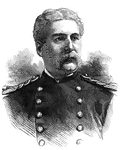
General Edward Hatch
"General Hatch, born in Bangor, Me., December 22nd, 1832. In April, 1861, he was a member of the District…
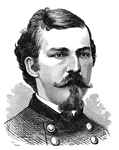
General Nelson Miles
"General Miles, born in Westminster, Mass., August 8th, 1839. General Miles served in the Civil War."—…
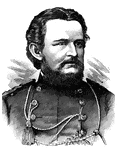
General Wesley Merritt
"General Merritt, born in New York city June 16th, 1836. He was graduated at the United States Military…
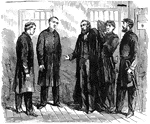
Execution Preparations
"Preparing the prisoner for execution- putting on the black robe."— Frank Leslie, 1896
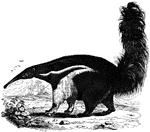
Tamanior
Inhabits most part of South America. About four feet in length. Spends the greater parts of its life…
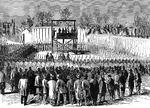
Captain Wirz's Execution
"Execution of Captain Wirz at Washington, D. C., Friday, November 10th, 1865."— Frank Leslie, 1896

Interior of Libby Prison
"Interior of Libby Prison, Richmond, Va., with prisoners from General Lee's army confined after the…
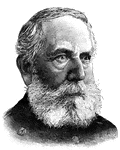
General William B. Hazen
"General Hazen, born in West Hartford, Vt., September 27th, 1830; died in Washington, D. C., January…

Battle of the Wilderness
"The battle of the Wilderness, between General Grant and General Lee, May 5th and 6th, 1864. Our sketch…

Prison Pen
"The great Prison Pen at Andersonville, Ga. The stockade was orginally eleven acres, which was increased…

Confederate Prison Camp
"The Confederate Prison camp at Belle Isle, James River, Va."— Frank Leslie, 1896

Millen Prison Pen
"The Prison Pen at Millen, Ga., as it appeared previous to the arrival of General Sherman's Army. Our…

Prison Pen at Columbia
"Appearance of the prison pen at Columbia, S. C., on the arrival of Sherman's army."— Frank Leslie,…
Prison Reception
"Reception of Confederate prisoners at the Federal prison, Elmira, N. Y. The prison at Elmira, N. Y.,…

Victory off Cherbourg
"The naval victory off Cherbourg, France, June 19th, 1864- the pirate Alabama Captain Semmes,…
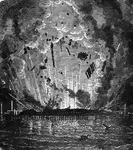
Siege of Mobile
"The siege of Mobile- explosion of Fort Powell, at Grant's Pass, July 5th, 1864."— Frank Leslie,…

General McGowen
"General McGowen addressing the Thirty-Fifth Abbeville (S. C.) Volunteers, in front of the Charleston…
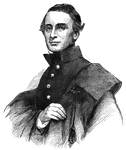
Major Robert Anderson
"Major Robert Anderson, the commander of Fort Sumter at the time of its fall, was born in Kentucky in…
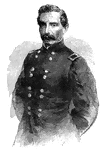
General P. G. T. Beauregard
"General Beauregard, who opened the Civil War by bombarding Fort Sumter, made a brilliant record during…
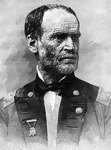
Lieutenant General William Tecumseh Sherman
"General Sherman, born in Lancaster, Ohio, February 8th, 1820; died in New York city, February 14th,…
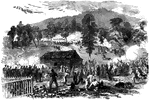
Battle of Rich Mountain
"The battle of Rich Mountain, Beverly Pike, Va., between a division of Major General McClellan's command,…

Floating Battery
"Scene on the floating battery, Charleston Harbor, during the bombardment of Fort Sumter. A very important…

Acquia Creek
"The attack upon the batteries at the entrance of Acquia Creek, Potomac River, by the United States…

Battle of Carrick's Ford
"Battle of Carrick's Ford, between the troops of General McClellan's command, under General Morris,…

Bealington
"Engagement at Bealington, Va., between Ohio and Indiana regiments and a detachment of Georgia troops.…

Zouave Cadets
"Group of Ellsworth's Chicago Zouave Cadets. No military organization during the war was more brilliant…

Billy Wilson Zouaves
"The ('Billy') Wilson Zouaves, at Tammany Hall, taking the oath of fidelity to the flag, April 24th,…

Funeral Cortege
"The funeral cortege, at boston, Mass., of the Sixth Massachusetts soldiers killed at Baltimore. The…

Major Zagonyi
"Second charge upon the Confederates by General Fremont's bodyguard, under Major Zagonyi, near Springfield,…

Sixteenth Regiment
"The Sixteenth Regiment, Ohio Volunteers, under Colonel Irwine, crossing the tray run viaduct, near…

Rhode Island Regiments
"Rhode Island Regiments embarking at Providence for New York and Washington. Within five days after…

Battle of Belmont
"Battle of Belmont, Mo., opposite Columbus, Ky, November 7th, 1861- Federal forces commanded by U. S.…

Fort Walker
"Landing of United States troops at Fort Walker, after the bombardment, November 7th, 1861. In order…
!["Morning mustering of the 'Contrabands' at Fortress Monroe, on their way to their day's work. As a living illustration of one of the aspects of the Civil War, a sketch is given above of the contrabands, [African Americans], going to their daily work at Fortress Monroe. The variety of the Ethiopian countenance is capitally given, and while some remind us of the merry phiz of George Christy in his sable mood, others wear the ponderous gravity of a New Jersey justice. The [African American] men had a comparatively pleasant time under their state of contraband existence."— Frank Leslie, 1896](https://etc.usf.edu/clipart/12400/12451/mustering_12451_mth.gif)
Morning Mustering
"Morning mustering of the 'Contrabands' at Fortress Monroe, on their way to their day's work. As a living…

Morning Detail
"The morning detail of the Fourth New Hampshire Volunteers going to work on the Hilton Head Fortifications.…

Fort Pulaski
"The bombardment of Fort Pulaski, second day, Friday, April 11th, 1862. General Quincy A. Gilmore took…
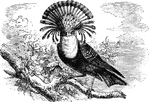
King Flycatcher
An impressive South American species of fly-catcher, with a transverse crest of reddish-fawn feathers.
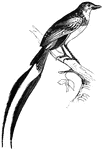
Tricolored Alectrurus
Native to South America, the tricolored alectrurus measures only six inches in length.

Red-Wing Thrush
The red-wing thrush migrates from the north to the south of Europe in the winter, feeding on worms and…
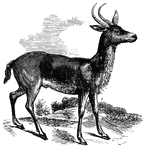
Inghalla
"Is of a deep reddish-fawn color; its lives in pairs or small families, frequenting the reedy borders…
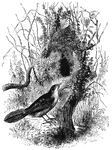
Pinc-Pinc
Found in South Africa, the pinc-pinc is about the size of a wren, and is named after its distinctive…
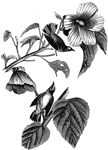
Blue-Winged Yellow Warbler
Found from Louisiana to New Jersey, the blue-winged yellow warbler migrates south to tropical parts…
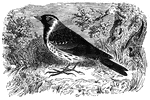
Common Snowbird
Found as far north as Greenland, the common-snow bird migrates as far south as Virginia in the winter.

Shore Lark
Found in the north of Europe and Asia, specimens of the shore-lark have been ound as far south as France…
